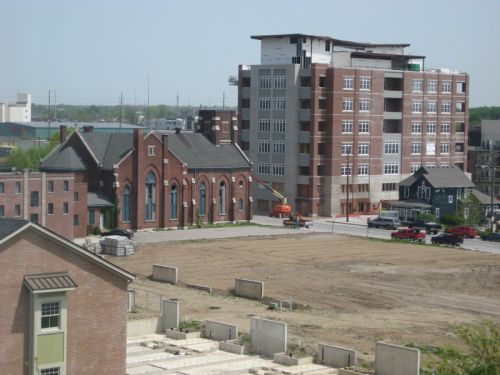 Kate Moran of the Times-Picayune in New Orleans produced a tremendous story for the Religion News Service, which was subsequently picked up by The Washington Post about the "cultural conversion of cast-off churches." It's a sad story in many ways, but the growing trend of lost church buildings is one that local journalists desperately need to start telling. It is a huge part of the larger story of what is happening in American cities from coast to coast:
Kate Moran of the Times-Picayune in New Orleans produced a tremendous story for the Religion News Service, which was subsequently picked up by The Washington Post about the "cultural conversion of cast-off churches." It's a sad story in many ways, but the growing trend of lost church buildings is one that local journalists desperately need to start telling. It is a huge part of the larger story of what is happening in American cities from coast to coast:
The McColl Center for Visual Art, a project that rescued a historic building from demolition and served as an economic jolt for a struggling corner of the city, provides a lesson for what might become of the two dozen churches that the Archdiocese of New Orleans plans to close and deconsecrate as part of a massive post-Katrina downsizing plan.
Archbishop Alfred Hughes has said he hopes to continue using the vast portfolio of decommissioned real estate to further the mission of the church or serve the common good. The archdiocese says it would sell its buildings to a developer only as a last resort.
But as priestly vocations have declined and church closings have become a fact of life across the country, many houses of worship have passed into the hands of developers, who have converted them to banquet halls, music clubs and condominiums.
Earlier this year The Chicago Tribune had a similar story about how abandoned churches are being converted into fancy condo buildings. I can report that Indianapolis now has at least two former churches that have been or are being converted into condo buildings and another old church is now home to two restaurants (which serves excellent food by the way).
As for the RNS story, it does a good job surveying trends around the country and captures the national trend from an economic and religious perspective.
There is a sense throughout the story that the topic is sacred, but more direct answers are needed to serious questions that surround this unfortunate trend. What is being lost as church buildings and all the community effort poured into the buildings drifts away? How many rich histories and cultural and spiritual traditions are being lost as these grand buildings become something other than the cultural and spiritual center of the communities they used to represent?
Consider what a community's reaction would be if a condo developer turned a grassy green park with benches and a some playground equipment in which generations of neighborhood residents played and relaxed into a 7-story condo building? From a pure economic and social standpoint, the loss of a house of worship to something as inspiring as yet another condo building is far greater than the loss of a park. And don't think I am trying to at all minimize the value of parks to a community's well being.
Here is the RNS article:
Churches are best used as churches, of course, and in many cases a growing congregation will buy one from an older denomination that can no longer sustain it. That's what happened in Boston, where the archdiocese retired 44 churches several years ago. About a quarter ended up being used by other religious groups.
Sarah Comiskey, a spokeswoman for the Archdiocese of New Orleans, said the church hopes to keep as many buildings as possible within the ambit of the Catholic faith. Catholic Charities, for example, has converted St. Cecilia Church into a day center for the elderly.
Elmore Rigamer, medical director of Catholic Charities, said it was more expensive to renovate the church than to erect a more utilitarian building from scratch. But the church setting, with its stained-glass windows and vaulted ceilings, gives the senior center's clients a sense of peace.
Consider the magnitude of the spiritual loss behind each of these buildings, and one can't help but wonder about the theological and spiritual dimensions behind the many stories that could be told. Each city is different, and each church building has a different story to tell. Reporters covering anything from development to community life cannot underplay the significance of this huge religion story.
Photo taken by the author of this post on Monday in a near northeast side Indianapolis neighborhood.
